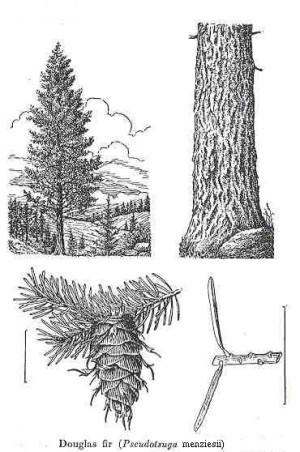Properties and Uses
Universally recognized for its superior strength to weight ratio, Douglas Fir is often the wood of choice specified by architects and engineers for use as structural timber. In strength, Douglas Fir rates the highest of any western softwood for:
- extreme fiber stress in bending
- tension parallel-to-grain
- horizontal sheer
- compression perpendicular-to-grain
- compression parallel-to-grain
Durability of its heartwood and excellent dimensional stability, are only a couple reasons why many builders around the world prefer Douglas Fir for framing timbers. It is the ideal general-purpose softwood for residential, light commercial, multi-story, industrial construction and structural form-work applications.
Douglas Fir is equally suitable for construction uses: in solid timbers (posts & beams), milled or hand hewn logs, post and poles, glued-laminated structural components, window and door frames, mouldings (spindles, baseboard, casings), cabinetry for kitchens and bathrooms, wall and ceiling paneling, flooring (floorboards or roof-boards), and other joinery work.
This species yields a fine-grain clear timber (knot free) in long lengths as well as factory grades (re-manufactured for clear recovery and construction). In colour, the narrow sapwood is light while the wider, more resilient heartwood ranges from yellowish to reddish brown. Summerwood has darker, more sharply defined bands, resulting in a distinctive grain pattern when the log is flat-sawn.
Cut wood seasons well, drying quickly and evenly, and remains straight with little checking or distortion, making it stable for structural applications that must withstand high loads. In its natural state, this wood has excellent decay resistance.
Surface appearance and easy-working properties such as the ability to glue well, good nail and screw holding ability, and an excellent capacity to accept paints and stains, make Douglas Fir suitable for widespread use.
About The Wood
Douglas Fir (Pseudotsuga menziesii) is Canada’s largest conifer tree and the strongest of British Columbia’s family of fine softwoods.
Also known as Coast Douglas-Fir, Oregon Pine, Oregon Douglas-Fir, Douglas Tree, and Interior Douglas-Fir, this species was named after Scottish botanist, David Douglas, who first introduced the tree into agriculture in 1826 and also launched many of BC’s native conifers in Europe.
Douglas Fir has been used for years in plywood, pilings, mine timbers and furniture. In earlier times, this strong and hardy wood was used in wharves, trestles, and bridge-building.
This tree grows on the southern mainland coast of British Columbia and Vancouver Island. An interior variety is also found throughout southern and central BC. The tall branch-free trunk has a distinctive thick reddish-brown bark and can reach heights up to 200 feet on the coast and 100 feet in the interior. Beneath the furrowed bark is a layer of sap that is highly sought after by bears.



